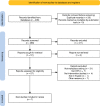Short High-Intensity Interval Exercise for Workplace-Based Physical Activity Interventions: A Systematic Review on Feasibility and Effectiveness
- PMID: 36840913
- PMCID: PMC10036456
- DOI: 10.1007/s40279-023-01821-4
Short High-Intensity Interval Exercise for Workplace-Based Physical Activity Interventions: A Systematic Review on Feasibility and Effectiveness
Abstract
Background: Workplace exercise interventions showed good results, but lack of time was often reported as a barrier to participation. To overcome this problem, several studies attempted to implement short high-intensity interval training (HIT) within the workplace.
Objectives: The aim of this systematic review is to explore the feasibility and effectiveness of HIT interventions within the workplace setting.
Data sources: A systematic literature search was conducted in PubMed and SPORTDiscus to identify articles related to HIT within the workplace.
Study eligibility criteria: Only interventions that consisted of HIT programmes within the workplace and tested at least one physiological, psychological, or work-related outcome were included.
Results: Seven studies (317 participants) met the inclusion criteria. HIT interventions lasted 6-12 weeks, with a frequency of 2-4 sessions/week and a duration of 8-30 min per session. Feasibility was qualitatively investigated in four studies, with key positive aspects reported for HIT time-appeal, the sense of competence driven by individual intensity, and improved intention to exercise; five studies reported adherence rates > 80%. Small-to-large effect sizes were reported for improvements in cardiorespiratory and muscular fitness. Small-to-medium effect sizes were reported for blood parameters and health-related quality of life.
Conclusions: HIT interventions in the workplace showed limited effectiveness in improving health-related outcomes, while promising results regarding feasibility were reported, mainly due to the time-efficiency and the positive post-exercise psychosocial responses. However, further high-quality studies involving more participants are still needed to make firm conclusions on HIT effectiveness and feasibility compared to other types of exercise in this context.
© 2023. The Author(s).
Conflict of interest statement
Stefano Amatori, Carlo Ferri Marini, Erica Gobbi, Davide Sisti, Germana Giombini, Rosalba Rombaldoni, Marco B.L. Rocchi, Francesco Lucertini, Ario Federici, Fabrizio Perroni, and Giorgio Calcagnini declare no conflicts of interest relevant to the content of this review.
Figures


References
-
- Goetzel RZ, Long SR, Ozminkowski RJ, Hawkins K, Wang S, Lynch W. Health, absence, disability, and presenteeism cost estimates of certain physical and mental health conditions affecting U.S. employers. J Occup Environ Med. 2004;46(4):398–412. doi: 10.1097/01.jom.0000121151.40413.bd. - DOI - PubMed
Publication types
MeSH terms
LinkOut - more resources
Full Text Sources
Medical
Miscellaneous

